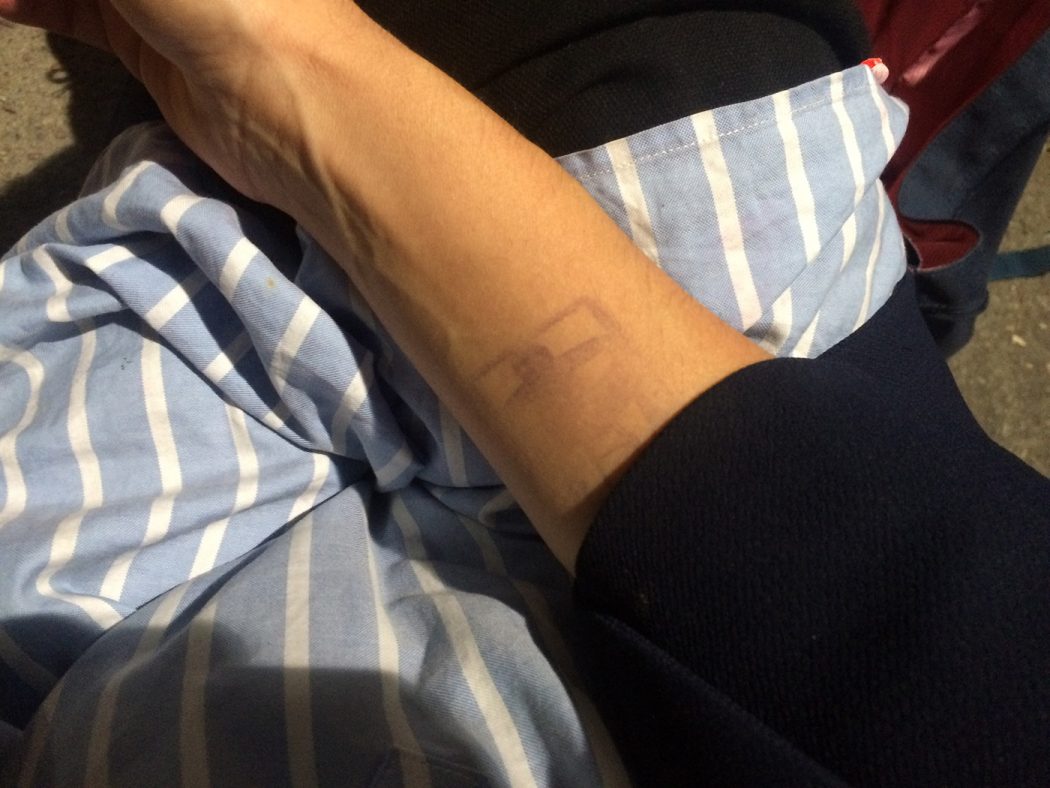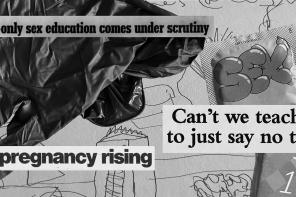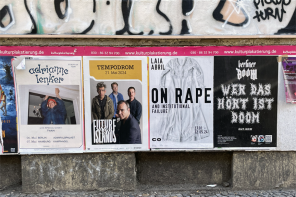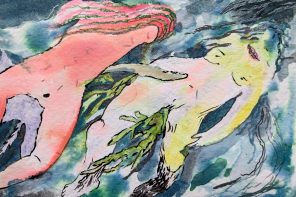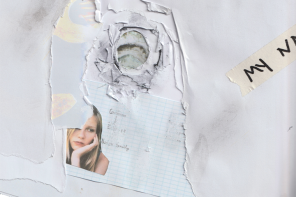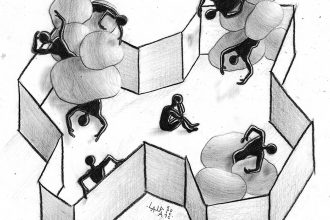I never felt the impact of ideas and theories expressed about music. I feel that they are a kind of intellectual punishment to music for being so accessible in an epidermal, sensory way. For getting where theory wishes to go and can’t—deep inside the body. Other texts, those from the music press, seem to be written by people who talk about experiences they never lived, weaving together one borrowed mannerism after another, like someone moving on the dance floor and imitating the movements of the stranger beside them, but without feeling it as their own. There are experiences that resist being told in words. They are moving experiences that only exist in motion. When we pause, they slip into a tidal wave of reminiscence and become part of the material memory of our bodies. The experience of dancing is one of them.
The history of music has also been written with the body, with all bodies that music has accessed and recorded itself within. It is not writing in its most literal sense, but we now know that the terms are not an end in itself, but temporary and contextual events. If I claim that dance is a type of writing, beyond the post-structural excesses that turn any reality into a text, it is because of the relentless editing process of dancing bodies. Re-appropriation and unending quotation, iconic gestures of dj culture, have been on the dance floor since its very beginnings. While dance culture remains a problematic term, it feels still more inclusive than dance music. It involves the subjectivity of those of us who do not produce music, but are produced by music. It acknowledges and praises dance, and consequently the body as a carrier element of an experience where many of us prefer to stay anonymous. I personally find it comforting that not everyone gets the same pleasure out of anonymity. Recognizing each other in anonymity creates a community very different from that of proper names, digital cheering, and algorithmic scattering. It is a community that understands how being present can be more important than being represented.
Despite their co-dependence, the relationship between the dj booth and the dance floor is binary, opposing and hierarchical. Booths long ago disappeared from clubs. They are archaeological areas banished by the unstoppable expansion of the culture that made them into being. Dj’s have been playing on stages for a long time. Sometimes I feel it’s a sort of revenge by a culture that dance music was intended to shift or counteract: concert culture, rock, and its euphorically masculine toxic bohemia. The presumed gender deconstruction of the dance floor fades away a few metres from the stage. Stages are not simply spaces where bodies get unidirectional relevance, they are places where the hero’s epic masculine logocentric narrative is activated over and over. Most djs and musicians love to perform this narrative. An economy of attention soaks up dance floor relational ethics. Supporting a scene is often misunderstood as self-promotion through the scene. Yet it is possible to turn your back on this logic even by dancing towards the dj.
With regard to the potential deconstruction of gender on the dance floor, the years have shown that the future is not always more subversive than the past. I started dancing drum’n’bass, techstep or hardtek as a kid, and ended up dancing techno like a woman. Moreover, I have consciously used techno as a sensual sensory device to explore expressions of femininity that for many years seemed not only unrelated, but banned to someone like me, who came to misunderstand feminist ethics with the dominance of misogynist reason. I am very much indebted to dance culture for my becoming a body. I admit to having been seduced by the progress and development narrative of the history of dance music, where one musical form surpasses another, improving it, towards a presumed better future forever in suspension. I wonder if otherness can also arise by overcoming forms of self-censorship, regardless of the identity outcome. I wonder if getting older has something to do with my unsettled re-edition of what it means to be a woman according to social prescriptions.
I first started dancing in clubs that could now be defined as night temples of hetero-cis-masculine testosterone. Paradoxically, I always felt welcome in them. I learned to perform in a way that was both friendly and distant in an environment that was potentially hostile to outsiders, especially if they were bodies carrying dissident masculinities. I was clearly an outsider for many reasons in the techno scene of that time in Valencia and later in Barcelona, but being a foreign girl played many times in my favour thanks to male-dominated indulgence. The gestures of my body also worked in my favour. They were a vocal disclaimer. My body displayed many sound detours, as well as my open disinterest in belonging to one scene or another. The logic of ally and enemy logic is part of the patriarchal affective narrative. I still enjoy transfering somatic memory from one music scene to another, creating tiny moments of strangeness on the dance floor. Things like counteracting the speed of techno with the slowness of dubstep, or undoing breakcore’s unprogrammed obsolescence in pretentious post-club music sessions. It is not only possible to unravel unwritten agreements by using our personal somatheque, but also to provide protective membranes by just moving. It is also possible to reclaim more space than the surrounding bodies allow us. I must confess that not having any idea what intersectional feminism was when I was 22 years old gave me quite a lot of room to maneuver. The enthusiasm for the ‘new’ outshined my general attention to the world. Dance floors crowded my imagination. I suppose I was then experiencing the recklessness of political unconsciousness. Or perhaps I was so empowered by the (self)invitation to take part of something that was not socially institutionalised at the time. I do admit that sometimes I miss that fiction of freedom that I find so hard to feel in what we might call iconic temples of gay-cis-masculine patriarchy. But it is still my body that decides what music to dance to, regardless of my ethical preferences regarding the body community that each scene engenders. Strategic glitches of otherness are also made of music for me.
The dictionary says that otherness is the ability to be other or different. Dictionaries are not neutral in their definitions. They produce concealed ideological violence, they make us believe in the willful subject. My Spanish word processor is also ideological. It points out to me that “otherness” is not a word. The contradiction it brings about is ironic and even funny. Language, a technology for otherness, sanctions us when we deviate from its rules. To be different from something, I would first have to understand or establish what that “something” is that I want to distance myself from. The desire for otherness is built from a certain relationship of proximity. We feel ourselves in the otherwise. There is something that we want to know, but that others also acknowledge. Otherness can never be a steady or stand-alone position, but a situated and contingent one.
Like sex, dancing is a low-intensity otherness practice. We never fuck the same way, we are never the same when we fuck. Sex is a relationship mediated by bodies that fuck. Fucking bodies are mediated by scripts, by ideological promises underlying sex. Sex is never just about fucking. Dancing is not just about dancing either. Dancing is the promise of what can happen to us while we are dancing. Dancing can be the (un)promised sex. On a dance floor it is possible to become another without touching each other, through shared (e)motion. We embody other bodies without fully surrendering to them. Dancing is a relationship between bodies mediated by music as a common contact surface. It is a form of communication through borrowed language. It is a technology of emotional synchrony thanks to the material synchronisation of bodies. By grasping and assembling the movements of someone nearby, we communicate with one another in the language of someone else. Otherness becomes plural. By being many others at the same time, we become a multitude in one body. Being implies contagion and not essence. Gestures do not belong to us: we are the ones who belong to them, they are the ones who activate the community.
You belong in Berghain! This is a phrase that Ania and I were told while dancing techno in a club in Barcelona years ago. It came from two German guys with bodies as ambiguous as ours in that environment. I don’t think they were referring to the club itself but to our way of dancing. Although we did not dance like them and did not dance like each other, they recognized in our gestures and movements that we were members of the same community. They recognized known bodies in unknown ones. It is true that some clubs are a factory of bodies, movements, and similar choreographies, but neither my body nor my way of dancing belongs to Berghain. Of course I have been touched by the Berlin techno scene when dancing, but I have also seen their steps and movements in documentaries of former dance scenes, such as the Belgian new beat of the nineties. The sweat of bodies carries the current nostalgia of dance music back to a foundational past that is both near and far. Fascination for the new is merged with infatuation for the old. Bodies can contain the memories of unlived times. Back in the days, my journeys to the future were in the glitchcore or idm nights. Techno provided me with the feeling that past, present, and future could happen together. With regard to the marks that scenes leave on our bodies, it is difficult to feel part of a club that includes among its many unspoken rules that you shouldn’t use your mother tongue if you want to get in. Disguise who you are. Don’t let it be noticed that you come from where you do. Dance floor politics challenge forms of oppression and exclusion that structure reality outside the clubs. Yet utopia is merely the feeling of utopia. Reality finds its way into the club. There are forms of xenophobia that don’t feel as such when they are naturalised and even trivialised by the very people who suffer from them. Not everything should be worthwhile just to get in. Scene diversity is still relative. For clubs to be distinctive, those of us who dance within them have to be conditionally similar to each other. Outfit becomes uniform, workers enter the dance factory to perform exhaustion and exuberance. We may not want to belong to a club—we want the club to belong to us.
More than four years ago I was dancing in a club in Tokyo. I mirrored the movements of someone who was dancing nearby. Months later, in a European club, someone borrowed the movements that I had taken from that person, which were probably borrowed from a previous body, and so on. Sometimes I fantasize about the possibility of a founding gesture, with a primal moment unfolding the unwritten history of embodied motion. It is made up of fleshly stories that come and go on dance floors. It is a somatheque that will never have a settled archive. The linear logic of historical events does not work here. The image of the uroboros takes on body. It offers a circular event and relates to forms of representation of anthropophagy. Bataille says that a kiss is the beginning of cannibalism. So is dancing. Otherness becomes a symbolic form of anthropophagy.
The uroboros connects with a living loop that restarts over and over again despite actions to prevent it. It brings me back to Tokyo. At the door of one of the rooms of the club there was a warning sign against entering with drinks. “Only dancing here!”, as someone told me. By excluding alcohol from the main room, I naively thought that the club supported in a somewhat dramatic way the main purpose of a dance floor. I would later discover that this was simply a legal issue. The club did not have legal permission to allow alcohol consumption inside its main room. Kentaro would also tell me how for a while in Japan, one wasn’t allowed to dance in clubs.There were ridiculous situations like reading “no dancing” signs when entering any of them. Like the uroboros, the dancing stream does not stop despite actions to prevent it. That ban vanished. It couldn’t stop a community that breaks many other social frameworks. But now the uroboros can’t kiss its own tail.
Imagine being able to change your voice, to speak with someone else’s voice. Imagine that many bodies can share the same voice. It is available to everyone, but it does not belong to anyone in particular. Expressions and gestures resist authorship. They do not belong to anyone in particular but some people certainly benefit from them more than others. Gestures and expressions are non-exclusive identity traits. They exist in multiplicity. They spread and flourish thanks to forms of anonymous involvement. Gestures create body communities. Style is nothing more than the passing of a fleeting memory from one body to another. Dancing is an abandonment of identities through movement. Gestures and sensations dance our bodies.
It would be misleading to claim that there are no differences on a dance floor or in a club. Club culture also creates its own oppositions and hierarchies. Still, statism holds some prestige in a community that praises movement. Dance till you drop, but don’t be histrionic. Choose trend gestures if you want to go unnoticed. Improve trends in motion if you want to be admired. Hold the scene in your body if you want to be followed. Aesthetics of dance are a social construction that promotes some bodies to the expense of others. Slim androgyny is a standard of elegance. If you are a dj, you better not dance. Uphold hierarchies between voice and listening, between logos and emotions, between individuals and crowds, between masculine and feminine, between mind and flesh. Resistance to self-dissolution coexists with dissolution of resistance.
The history of dance culture reproduces the historiographic paradigm. It is precisely submission to this paradigm that determines the validation of stories. It is often presented as a linear succession of data, stages, names, discoveries, and technological improvements that seem to work and fit together according to a common purpose. Underlying it is the teleology of the future, and also of serendipity. It is a rarely criticized mythography by those who participate in and benefit from its privileges. It is strongly masculine and excuses itself, like so many others histories, from confronting why so few women participate. As if this were random or intentional. It is likewise the history of expressions of resistance that ended up being swallowed by the very system they seemed to contest. It is a story that does not involve dancing. It makes it a footnote. Dancing is something that happens while other more important things are happening. It is a history with no interest in the aesthetics of its motion. It highlights the dance floor by turning it into a space for subaltern actors. We are passive elements at the service of the history of dance music. We are often an alibi for the industry. We are information carriers for more significant content. We are bodies with no discourse in the service of unbodied discourses. We are no-body. And yet, to keep on dancing is an act of resistance. To keep on reclaiming dance floors as spaces (un)made by us that (un)make us. To keep on insisting on the potential, the ephemeral, and the eventual. To keep on holding the material intelligence of the body: the sweat, the smell, the urine, the saliva, the altered states of consciousness in blood. To move in the matter of dance as a carrier of bodies and stories that resist, still. I think of modes of feminism as dance; we hear histories in music; we reassemble histories by putting them into bodies that dance#.
* This text is a re-work of an earlier text in Spanish with the same title that was published in esnorquel in early 2018. It is written in a borrowed language that carries the memory of the mother tongue.
Although many people have accompanied me on the dance floor over the years, friends, acquaintances and strangers, in this text I refer to Kentaro Terajima and Ania Nowak. With Kentaro, techno has been a constant presence in our friendship, continuously developing our relationship. To Ania I thank her for our onsite analysis and her massage during hours of restless dancing near and far from her.
# This final sentence is an appropriation and modification of a quote from Sarah Ahmed that I found on Twitter at the end of the writing process in 2018: “I think of feminism as poetry; we hear histories in words, we reassemble histories by putting them into words.”
Words by Sonia Fernández Pan
Sonia Fernández Pan is a (in)dependent curator, writer, researcher, podcast-maker and anonymous body on the dance floor. Both her perception of dance culture and her way of dancing continue to shift constantly over the years. Her passion for techno is matched by many other musical genres, such as d’n’b, breakcore, dubstep or acid house, to name a few. She started her activity on the dance floor in 2003 at Barraca club (Valencia, ES) and continued dancing in many illegal free parties, many festivals and clubs like Octopus (Pontecesures, Spain), Razzmatazz and Apolo (Barcelona, Spain), Fabric (London, UK), Contact (Tokyo, Japan), Berghain, ://about blank, Tresor, OHM (Berlin, Germany) to mention those she still remembers. After 13 years in Barcelona, she moved to Berlin for musical reasons, among many others. Since 2018, she is co-curating You Got To Get In To Get Out for/with La Casa Encendida (Madrid), a long-running research project from/to techno that is growing collectively thanks to a radio, a book and a final exhibition to be held in autumn 2021. She writes erratically about club culture for different media. Off the dance floor she hosts the ongoing podcast series Feminism Under Corona and Feminisms in the Caribbean for/with Institut Kunst (Basel) and Corona Under the Ocean for/with TBA21–Academy & Institut Kunst.

